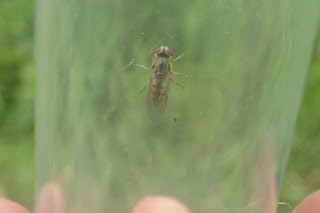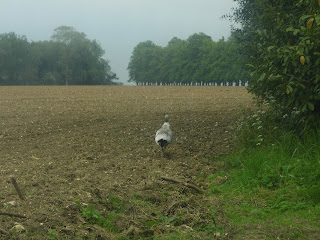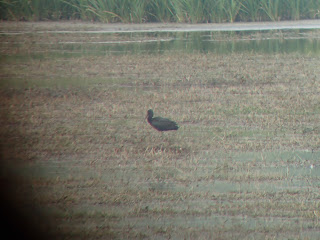We started off at 1am, much earlier than normal. The reason for this was that we had decided to head to the Nene Washes in Cambridgeshire, aiming to hear Corncrake. This is a species that I'd not seen or heard in the wild before, and as the birds here are descendents from a relatively recent reintroduction scheme, there is a reasonable arguement for saying I still haven't. As it is I like to see a bird before adding it to my life list, so these hae gone onto an appendix, rendering the arguement null and void, however importantly Ian Dearing (one of the organisers of Bird Race Challenge) had confirmed prior to the event that for bird race purposes they were countable.
There was little to see on the journey across Norfolk, a Fox near King's Lynn being the only sighting of note. That all changed as we approached the Nene Washes, when we spotted a Badger at the side of a minor road. Further along we saw two more, including one that trotted sheep-like along the road in front of the car before darting off into the hedge. This was only my third sighting of live Badgers, so was particularly pleasing. Another Fox was also seen nearby. Gary and Alysia in the front of the car saw a Tawny Owl fly up into a tree, but Adam and I in the back missed it. Bird race rules state that all members of a team must see a species for it to count, so it stayed off for now.
Our Tawny Owl stop did result in the first two birds of the day being added to our list. Some Woodpigeons noisily left a tree, and a Little Grebe called from nearby. Carrying on down the road we parked up and set off along a footpath that runs along a large expanse of washland. A Bittern boomed loudly, which is always a pleasing sound - we heard or saw at least four birds during the day. The wetland warblers were in good song, Cetti's and Reed were numerous, whilst Sedge and Grasshopper were also heard. Various other common species called, but finally we heard the 'crex crex' call of Crex crex - the Corncrake. Our main target heard, and a new experience for Alysia and I.
Corncrake was our 17th bird of the day, the 18th was a Barn Owl, and we were endebted to Gary for noticing our 19th bird, the 'whip whip' song of a Spotted Crake! We had two excellent birds on the list, plus things like Bittern and Grasshopper Warbler that can be tricky, but the time it would tkae to get to our first Breckland stop was a slight concern, and as a result we decided against a planned search for calling Long-eared Owls and headed straight for Santon Downham. As we passed Crimplesham I remarked it would be nice to have a bird on the list from here, perhaps a Robin or Blackbird would be singing? We slowed down, a Blackbird was singing from a telegraph pole. Predictive birding wins again. A Rook at Wereham took us to 21.
It was already light when we arrived at Santon, but then we were a fortnight later than our usual visits. Common woodland birds were added at a constant rate, Treecreeper and Cuckoo the best of the birds heard from the roadside. At the bridge Adam pointed out a Kingfisher, another decent bird to see early on. This is now a reliable sight for Mandarin, but there was a bonus in the form of a female with three ducklings. Garden Warbler and Lesser Redpoll were added to the list, but only Gary saw a Water Rail skulking in a dyke, so it joined Tawny Owl on the nearly list.
To dark and fast to get them in focus!
Last year we got great views of Lesser Spotted Woodpecker, but this year we were out of luck, despite spreading out along the path to focus on a section of woodland each. By this point we had seen most of the other likely woodland species (Nuthatch, Great-spotted Woodpecker, Marsh Tit), so eventually we gave up and headed back along the path, seeing Grey Wagtail on the way. Back at the bridge we met Chris, who pointed out two
Otters in the river and told us about his sightings nearby. At this point we also bumped into the main Bird Race Challenge team, who seemed very cheery for that early in the morning! After brief introductions we each headed in opposite directions.
Next up we checked a couple of nearby clearings, seeing Woodlark and Tree Pipit, the latter saving us a trip to our usual site for them. It was then on to Lynford, where we first checked out Lynford Water, before heading into the arboretum. One of the first birds we saw was a Spotted Flycatcher, which then perched up with a second bird. We were pleased to see these declining birds, although as it turned out there were several around the county during the day. Some Crossbills and a singing Firecrest meant we reached 71 species by 08:00.
We added a few more birds on some nearby farmland, and also watched four Brown Hares chasing each other around, before heading for a quick look for Golden Pheasants. It was always going to be a long shot and so it proved, although I did get a chance for a quick look for insects, finding a Hornet.
After a short debate, we decided to go to Great Livermere to look for a Black-necked Grebe seen there recently. Unfortunately none of us had been before so we weren't quite sure where to view from. We did pick up
Tree Sparrow and Grey Partridge nearby, and a white Peahen that we hoped would be added in the event of a tiebreak. We stopped at Great Livermere church, where thanks mainly down to luck we found a path down to the lake. We added some gulls amongst other things, but no sign of the grebe. On the way back I remarked that the scrub looked good for Lesser Whitethroat, and before we exited the field Gary found one.
From here we headed to a bridge over the A11 where a
White Stork was present in a nearby field. At least that was what we had been told, but we couldn't see it, and took to staring at a white and black thing (probably some rubbish), until another birder showed us a photo he had just taken of the Stork. It turns out it was visible, but only from a short stretch of path just at the edge of the bridge. We noticed a road close behind the Stork, but upon investigation it appeared to be a private Elvedon Estate track so we didn't get any closer views.
Next stop was Lakenheath Fen, where after availing ourselves of the facilities we went up to the washland viewpoint. A
Glossy Ibis stood in the middle of the pool, Common Terns flew past and two
Black-winged Stilts wandered about to our right. A Barn Owl flew past (we had heard one previously but nice to see nonetheless) and two Hobbies were visible in the distance.
By now we were a bit behind time, so headed off to Welney. Yellow Wagtail and Kestrel were seen on route (near Shippea Hill), the latter bringing up our 100 species at 11:35. In past years we have racked up a good number of additions at Welney, but this year we didn't. There was no sign of any Little Ringed Plover, Common Sandpiper or Garganey from the main hide, and we didn't have time to check out the others. Summering Whooper and Bewick's Swans were seen, along with Avocet and a surprise Red-crested Pochard, but moral had dropped a bit as we left.
We headed up to the North Norfolk coast, calling in at Flitcham hoping for Little Owl and Yellow-legged Gull. Both had been seen earlier in the day, and both were missing. Med Gull and Red Kite were some consolation, as we headed to Hunstanton to look for Fulmars. The tide was out, enabling us to add five wader species as well as Fulmar, before carrying on to Holme to look for a Pied Flycatcher reported from the car park. The gate attendant didn't know anything about it, and as we arrived Bob Cobbold told us the only bird currently in the car park trees was a Spotted Flycatcher. He actually used slightly fruitier language than that, but the meaning was the same.
As in the past few years there were
Dotterel at Choseley, so we called in, saw them and left, to the slight bemusement of the other birders present. We arrived at Titchwell about 16:00, and knew we needed to add a lot of birds here to post a competitive total. It started well with a singing
Wood Warbler in the car park, only my second Norfolk record of this species. We couldn't see or hear the reported Yellow-browed Warbler on the meadow trail, and nobody we spoke to had seen it, so we carried on down to the freshmarsh where Brent Goose became our 120th bird at 16:20. We couldn't find the reported Ruff or Little Stint, so headed down to the beach, where Little Tern, Sandwich Tern and Velvet Scoter were all decent additions.
After leaving Titchwell we headed further along the coast to Holkham, hoping for lingering Pink-footed Geese. We didn't see any, although a flypast Bittern was well worth seeing.
Great White Egret was the only addition here, taking us to 129. We were in danger of not reaching last year's total of 140 despite the extra effort, so we had an important decision to make - did we stay in North Norfolk, go to Potter Heigham or keep to our original plan to head to Minsmere. In the end we opted for the latter, which did mean that no new birds were added until we reached Dunwich at 19:20.
From Dunwich Cliffs we saw our 130th bird, long overdue Sand Martins. Dartford Warbler and Stonechat were added on the heath nearby, and Kittiwakes flew offshore towards their nests on a platform near Sizewell. We 'scoped Barnacle Goose over at Minsmere, and a Water Rail called, taking us to 135 and renewing hope of a competitive total.
Back in the car we headed round to Minsmere and scanned for Stone Curlew from the watchpoint. We couldn't find any, but a Short-eared Owl was a bonus. Bearded Tits pinged nearby, and Whimbrel, Common Gull and Caspian Gull from East Hide ensured at least a personal best-equalling tally of 140 at 20:35. Back at the watchpoint and my 'scope was out of action as the quick release plate screw had broken off. Adam was scanning and called a Stone Curlew. We asked if it was one with long ears that hopped about, but a quick look down the 'scope showed he had indeed found one, so we apologised and headed off.
It had just gone dusk, so before leaving Minsmere we went down to Island Mere hide, hoping to hear the Savi's Warbler that had been present for a while there. We didn't, frustratingly, but calling Little Owl and Tawny Owl (it could have been bird #1, it ended up being #143) meant it wasn't a wasted spell. It was now dark, but we still had a few targets, including
Nightingale, heard at Westleton Heath. Moving on to Dunwich we heard a distant
Nightjar, but concerned that we might be deluding ourselves with the background noise we went back to Westleton where an unequivicol one was churring. A Nightingale sung loudly from beside the car.
It had just gone 22:00 and we had reached a new personal record of 145 species. We had one last bird to try for, Quail, in the fields around Westleton. We stopped and listened to no avail, so headed off to the finish line at the World Land Trust headquarters in Halesworth. When we arrived there was nobody there, so we didn't really know what to do. Just as we were pulling out the World Land Trust team arrived, so we followed them into the car park and asked if we could park there. "We're the Norfolk Loons" I announced, aware that Suffolk birders probably hear this whenever interloping Norfolk birders talk to them. Fortunately Dan was aware of our team name, and invited us in for a welcome hot drink.
The Bird Race Challenge team arrived as we were going in, and we all had a debrief chat with the other team members. John Burton then turned up, ostensibly to present the Bird Race trophy (the Nene egg signed by Peter Scott used as trophy in the original Country Life vs ffPS bird races), but also to give out champagne and tut at the birds we'd missed out on! We were all rather tired by this point, so I suggested we make a move and head back to Norwich. The results of the Virtual Bird Race were announced on Monday evening, and we had been soundly beaten by Jake and Drew, who managed an astonishing 158 species, so well done to them.
Thanks of course to my fellow team members, particularly Gary who did all of the driving, and to the World Land Trust for their hospitality.
Norfolk Loons 2017 - left to right: James Emerson, Gary White, Alysia Schuetzle and Adam Pointer. Photo taken by Andrew Whitelee.
The Virtual Bird Race and Bird Race Challenge aimed to raise money and awareness for a World Land Trust project to save the endangered Blue-throated Macaw, and the fundraising page is still open should anyone who hasn't donated wish to do so:
https://www.justgiving.com/fundraising/NorfolkLoons
More sedate, non-sponsored activity will resume shortly.




















































